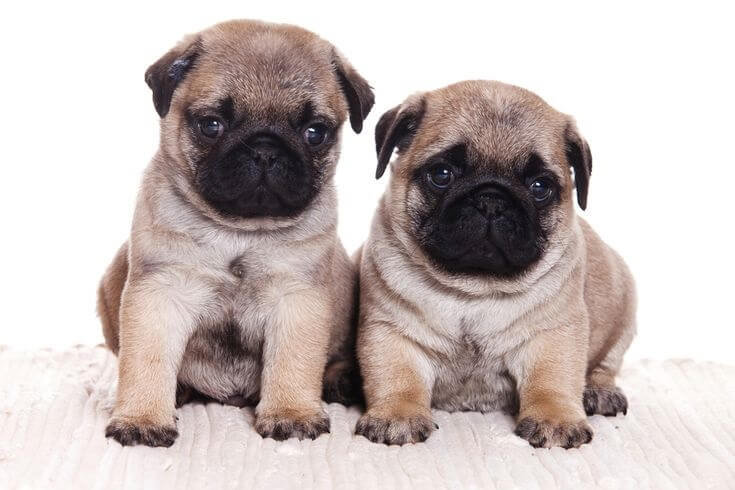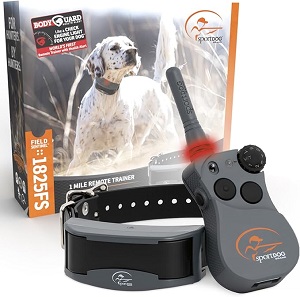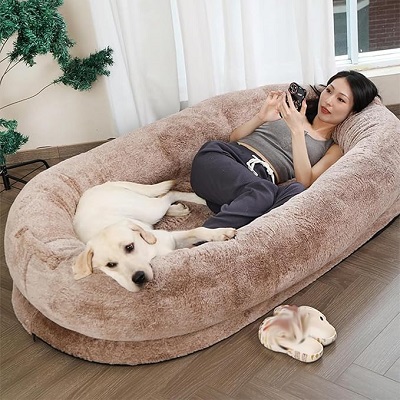
Pugs
Pugs are a small, charming dog breed known for their distinctive appearance, playful personality, and affectionate nature. They are one of the most popular toy breeds and are well-loved for their unique characteristics. Here’s a comprehensive overview of Pugs:
Physical Appearance:
- Size: Pugs are small dogs, typically weighing between 14 to 18 pounds (6.3 to 8.2 kg) and standing about 10 to 14 inches (25 to 36 cm) tall at the shoulder.
- Build: They have a compact and sturdy build with a square-shaped body, short legs, and a broad chest. Their body is well-proportioned, giving them a strong and solid appearance.
- Face: Pugs are famous for their wrinkled, flat faces (brachycephalic) with a short muzzle, which gives them a distinctive and endearing look. Their large, expressive, dark eyes are one of their most notable features.
- Coat: Pugs have a short, smooth, and glossy coat that lies close to the body. Their coat is easy to maintain and comes in various colors, including fawn, black, silver, and apricot.
- Tail: They have a curled tail that is often described as a "corkscrew" shape, which adds to their unique appearance.
Temperament and Personality:
- Affectionate and Loyal: Pugs are known for their loving and affectionate nature. They form strong bonds with their families and thrive on companionship.
- Playful and Fun-Loving: Pugs have a playful personality and enjoy interactive play. They are often described as clowns and love to entertain their owners with their antics.
- Sociable and Friendly: Pugs are generally friendly and sociable dogs. They tend to get along well with other pets and children, making them great family companions.
- Curious and Intelligent: While they can be a bit stubborn, Pugs are intelligent dogs that enjoy learning new tricks and commands. They thrive on mental stimulation and engagement.
- Vocal: Pugs can be quite vocal and may use barking, grunting, or snorting sounds to communicate with their owners.
Exercise and Activity Needs:
- Moderate Exercise Requirements: Pugs require regular exercise to maintain a healthy weight and prevent obesity. Daily walks and playtime are essential to keep them fit.
- Indoor Play: They are adaptable to living in apartments or smaller spaces, as they can get adequate exercise indoors through play.
- Avoid Overexertion: Due to their brachycephalic nature, Pugs can be prone to overheating. It’s important to avoid intense exercise in hot weather and ensure they have access to shade and water.
Training and Socialization:
Essentials for Your Newly Adopted Pet
Welcoming a shelter pet into your life is a beautiful journey. Here are some handpicked items to help your new friend feel safe, loved, and right at home:
- Positive Reinforcement: Pugs respond well to positive reinforcement training methods. Treats, praise, and play are effective motivators for learning.
- Early Socialization: Early socialization is crucial for Pugs. Exposing them to various people, pets, and environments helps them become well-rounded adults.
- Basic Obedience Training: Teaching basic commands such as sit, stay, and come is essential for their safety and good behavior.
- Consistency and Patience: Pugs can be a bit stubborn, so training should be approached with consistency and patience. Keeping training sessions fun and engaging will help keep their attention.
Health and Lifespan:
- Lifespan: Pugs typically live between 12 to 15 years, although some may live longer with proper care.
-
Common Health Issues:
- Brachycephalic Airway Syndrome: Due to their short muzzles, Pugs can experience breathing difficulties and are more susceptible to heat exhaustion.
- Eye Problems: Pugs are prone to various eye conditions, including cataracts, corneal ulcers, and dry eye.
- Skin Issues: Their facial folds require regular cleaning to prevent infections. They can also be prone to allergies and skin irritations.
- Obesity: Pugs have a tendency to gain weight, so proper diet and exercise are essential for maintaining a healthy weight.
- Hip Dysplasia: Some Pugs may be affected by hip dysplasia, which can lead to joint pain and mobility issues.
- Routine Veterinary Care: Regular check-ups with a veterinarian are essential to monitor health and catch potential issues early.
Grooming Needs:
- Low Grooming Requirements: Pugs have a short coat that requires minimal grooming. Regular brushing can help reduce shedding and keep their coat healthy.
- Bathing: They do not require frequent baths, but occasional bathing is necessary to keep their skin and coat clean.
- Face Care: The facial wrinkles should be cleaned regularly to prevent moisture buildup and skin infections. A damp cloth can be used to wipe between the folds.
- Nail Trimming and Dental Care: Routine nail trimming and dental care are important for overall health.
Living Conditions:
- Adaptable: Pugs are adaptable and can thrive in various living situations, including apartments, as long as they receive enough love, attention, and exercise.
- Indoor Dogs: They are primarily indoor dogs and enjoy being close to their families. They should not be left outside for extended periods, especially in extreme weather.
- Temperature Sensitivity: Pugs are sensitive to extreme temperatures due to their brachycephalic nature. They should be kept in a comfortable indoor environment and monitored in hot weather.
Pugs as Family Dogs:
- Excellent Companions: Pugs are known for their affectionate and playful nature, making them great companions for families and individuals alike.
- Good with Children: They tend to be good with children, especially if raised together. Supervision during playtime is essential to ensure safety.
- Compatibility with Other Pets: Pugs generally get along well with other pets if socialized properly from a young age. Early introductions and supervision are key to a harmonious household.
Working Roles for Pugs:
- Companion Dogs: Pugs were primarily bred as companion dogs and excel in this role due to their affectionate and social nature.
- Therapy Dogs: Some Pugs are trained as therapy dogs, providing comfort and companionship to individuals in hospitals and nursing homes.
History of the Pug:
- Origins: Pugs are believed to have originated in China around 400 B.C. They were bred as companion dogs for Chinese royalty and were highly valued.
- Development: The breed made its way to Europe in the 16th century and became popular among the aristocracy. Pugs have been depicted in art and literature throughout history.
- Recognition: Pugs were recognized by major kennel clubs, including the American Kennel Club (AKC), in the early 20th century.
Summary:
Pugs are small, affectionate, and playful dogs known for their distinctive appearance and charming personalities. With proper training, socialization, and care, they make excellent companions for families and individuals alike. Their adaptability, friendly nature, and love for companionship make them one of the most beloved dog breeds worldwide.
Affiliate Products
Up to 75% Discount

Dog Collar with Health Monitoring
BUY NOW »
Up to 55% Discount

Luxury Faux Furhuge Napping Bed
BUY NOW »

